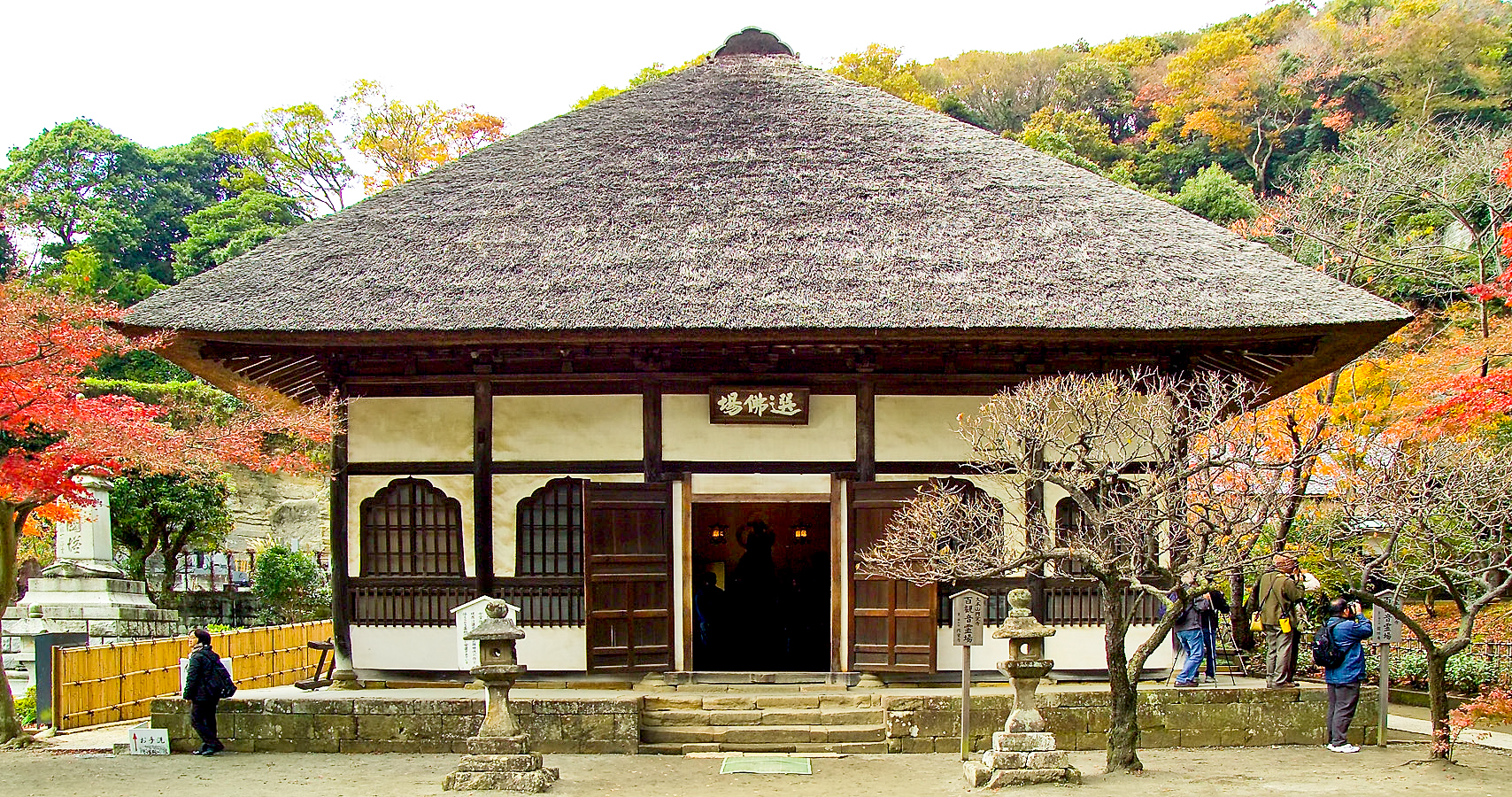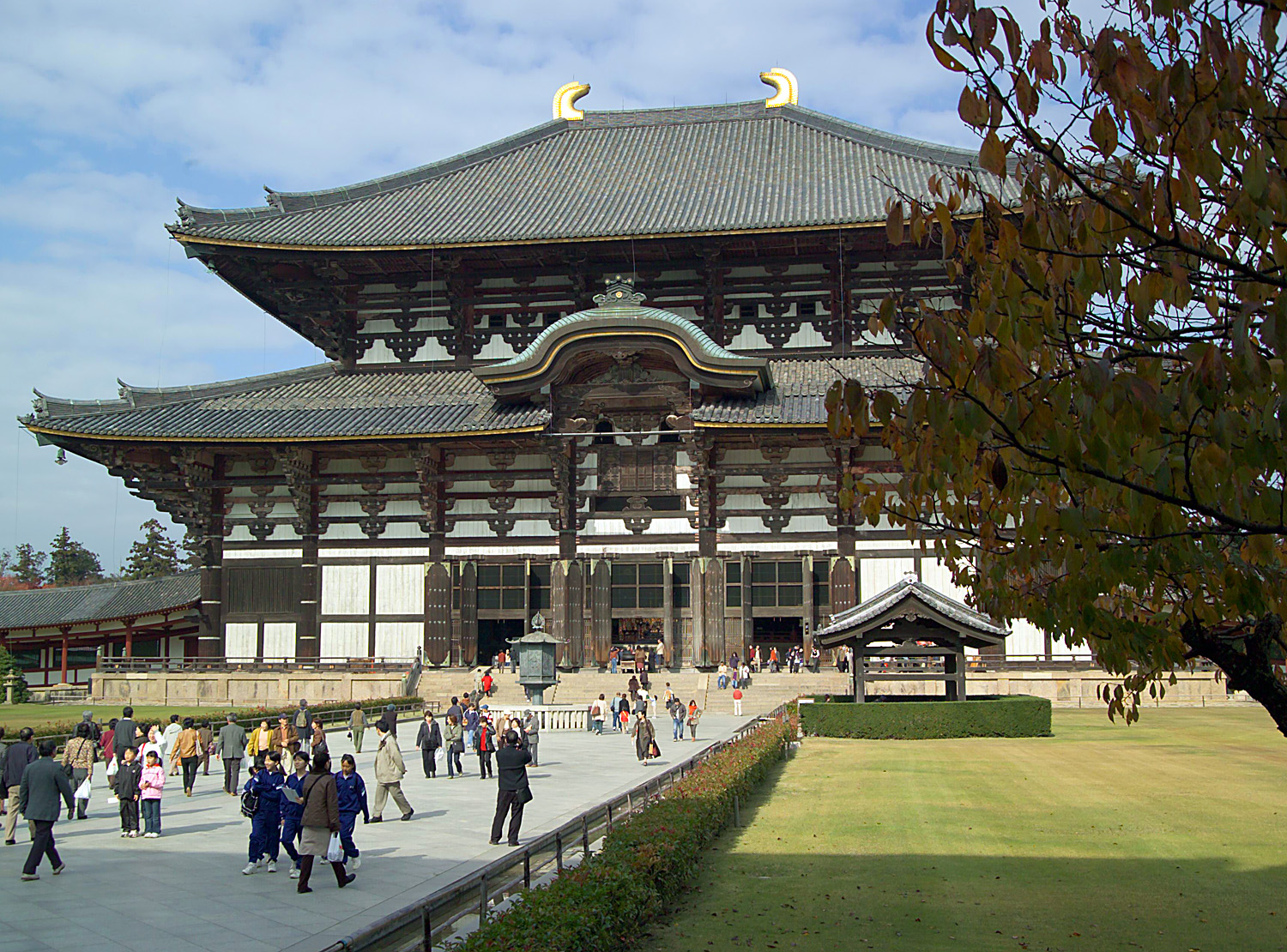|
Katōmado
, also written , is a style of pointed arch or bell-shaped window found in Japanese architecture.In English, this type of window is also simply called "wikt:cusped, cusped window". It first arrived in Japan from China together with Zen Buddhism, as an element of Zen'yō, Zen style architecture, but from the end of the 16th century it started to be used in temples of other Buddhism in Japan, Buddhist sects, Shinto shrines, Japanese castle, castles, and samurai residences as well. The window initially was not flared, but its design and shape changed over time: the two vertical frames were widened and curves were added at the bottom. The ''kanji'' characters used for its name have also changed through the centuries, from the original "fire window" to "flower head window". The oldest extant example of ''katōmado'' can be found in Engaku-ji's ''Shariden'' (Relic Hall)This hall was moved to its current location in 1563.(source: ) The original is believed to have been built sometime bet ... [...More Info...] [...Related Items...] OR: [Wikipedia] [Google] [Baidu] |
Japanese Buddhist Architecture
Examples of Buddhist architecture in Japan Japanese Buddhist architecture is the architecture of Buddhist temples in Japan, consisting of locally developed variants of architectural styles born in China.p=716/ref> After Buddhism arrived from the continent via the Three Kingdoms of Korea in the 6th century, an effort was initially made to reproduce the original buildings as faithfully as possible, but gradually local versions of continental styles were developed both to meet Japanese tastes and to solve problems posed by local weather, which is more rainy and humid than in China. The first Buddhist sects were Nara's six ,The six sects were called Sanron-, Jōjitsu-, Hossō-, Kusha-, Ritsu-, and Kegon-shū. followed during the Heian period by Kyoto's Shingon and Tendai. Later, during the Kamakura period, in Kamakura were born the Jōdo and the native Japanese sect Nichiren-shū. At roughly the same time, Zen Buddhism arrived from China, strongly influencing all other sects i ... [...More Info...] [...Related Items...] OR: [Wikipedia] [Google] [Baidu] |
Kamakura, Kanagawa
is a city in Kanagawa Prefecture, Japan. Kamakura has an estimated population of 172,929 (1 September 2020) and a population density of 4,359 persons per km² over the total area of . Kamakura was designated as a city on 3 November 1939. Kamakura was the ''de facto'' capital of Japan from 1185 to 1333 as the seat of the Kamakura Shogunate, and became the nation's most populous settlement during the Kamakura period. Kamakura is a popular domestic tourist destination in Japan as a coastal city with a high number of seasonal festivals, as well as ancient Buddhist and Shinto shrines and temples. Geography Surrounded to the north, east, and west by hills and to the south by the open water of Sagami Bay, Kamakura is a natural fortress. Before the construction of several tunnels and modern roads that now connect it to Fujisawa, Ofuna ( ja) and Zushi, on land it could be entered only through narrow artificial passes, among which the seven most important were called , a name so ... [...More Info...] [...Related Items...] OR: [Wikipedia] [Google] [Baidu] |
Glossary Of Shinto
This is the glossary of Shinto, including major terms on the subject. Words followed by an asterisk (*) are illustrated by an image in one of the photo galleries. __NOTOC__ A * – A red papier-mâché cow bobblehead toy; a kind of ''engimono'' and an ''omiyage'' (a regional souvenir in Japan) that is considered symbolic of Aizu. * – A type of fan held by aristocratic women of the Heian period when formally dressed; it is brightly painted with tassels and streamers on the ends. Held today in Shinto by a ''miko'' in formal costume for festivals. See also ''hiôgi''. * – The term's meaning is not limited to moral evil, and includes misfortune, inferiority and unhappiness. * - A malevolent fire spirit, demon or devil. * - Also known as the ''Akujin'', the ''Kibi-no-Ananowatari-no-Kami'' and as the ''Anato-no-Kami'', ''Akuru'' is a malevolent ''kami'' that is mentioned in the ''Keikoki'' (records regarding the time of the Emperor Keiko), the ''Nihonshoki'' (Chronicles of ... [...More Info...] [...Related Items...] OR: [Wikipedia] [Google] [Baidu] |
Genji (era)
is a after ''Bunkyū'' and before '' Keiō.'' This period spanned only slightly more than a single year from March 1864 through April 1865. The reigning emperor was . The new era name was derived from the ''I Ching''. Change of era * March 27, 1864 (''Bunkyū 4/Genji 1, 20th day of the 2nd month'') : The new era name of Genji (meaning "original rule") was created to mark the beginning of a new 60-year cycle of the Chinese zodiac. The old era ended and a new one commenced in ''Bunkyū'' 4. Events * July 8, 1864 (''Genji 1, fifth day of the sixth month''): The Ikedaya Jiken, also known as the Ikedaya Affair or Ikedaya Incident, developed at the Ikedaya ryokan in Kyoto. * August 12, 1864 (''Genji 1, 11th day of the 7th month''): Sakuma Shōzan is assassinated at age 53. He had traveled from Edo to Kyoto on orders of the shogunate. He was in favor of steps which would lead to an opening of the country, but his voice was stilled by death at the hands of a '' sonno joi'' sup ... [...More Info...] [...Related Items...] OR: [Wikipedia] [Google] [Baidu] |
Shiga Prefecture
is a prefecture of Japan located in the Kansai region of Honshu. Shiga Prefecture has a population of 1,412,916 (1 October 2015) and has a geographic area of . Shiga Prefecture borders Fukui Prefecture to the north, Gifu Prefecture to the northeast, Mie Prefecture to the southeast, and Kyoto Prefecture to the west. Ōtsu is the capital and largest city of Shiga Prefecture, with other major cities including Kusatsu, Nagahama, and Higashiōmi. Shiga Prefecture encircles Lake Biwa, the largest freshwater lake in Japan, and 37% of the total land area is designated as Natural Parks, the highest of any prefecture. Shiga Prefecture's southern half is located adjacent to the former capital city of Kyoto and forms part of Greater Kyoto, the fourth-largest metropolitan area in Japan. Shiga Prefecture is home to Ōmi beef, the Eight Views of Ōmi, and Hikone Castle, one of four national treasure castles in Japan. History Shiga was known as Ōmi Province or Gōshū before the ... [...More Info...] [...Related Items...] OR: [Wikipedia] [Google] [Baidu] |
Ishiyama-dera
is a Shingon temple in Ōtsu in Japan's Shiga Prefecture. This temple is the thirteenth of the Kansai Kannon Pilgrimage. History It was constructed around 747 CE, and is said to have been founded by Rōben. The temple contains a number of cultural assets. The temple possesses two fragments of manuscripts of the ''Records of the Grand Historian'' (''Shiji'' 史記), the first of China's 24 dynastic histories, which are the only known extant fragments that pre-date the Tang dynasty (618907). According to literature available at the temple complex, the guardian carvings at Sanmon/Todaimon are by Tankei and Unkei. Allegedly, Murasaki Shikibu began writing '' The Tale of Genji'' at Ishiyama-dera during a full moon night in August 1004. In commemoration, the temple maintains a Genji room featuring a life-size figure of Lady Murasaki and displays a statue in her honor. The temple features as "The Autumn Moon at Ishiyama" ( ') in the ''Eight Views of Ōmi'' thematic series in art ... [...More Info...] [...Related Items...] OR: [Wikipedia] [Google] [Baidu] |
Main Hall (Japanese Buddhism)
Main hall is the building within a Japanese Buddhist temple compound ('' garan'') which enshrines the main object of veneration.Kōjien Japanese dictionary Because the various denominations deliberately use different terms, this single English term translates several Japanese words, among them ''butsuden'', ''butsu-dō'', ''kondō'', ''konpon-chūdō'', and ''hondō''. ''Hondō'' is its exact Japanese equivalent, while the others are more specialized words used by particular sects or for edifices having a particular structure. Kondō (Asuka and Nara periods) The term started to be used during the Asuka and Nara periods. A ''kondō'' is the centerpiece of an ancient Buddhist temple's ''garan'' in Japan. The origin of the name is uncertain, but it may derive from the perceived preciousness of its content, or from the fact that the interior was lined with gold. This is the name used by the oldest temples in the country.Iwanami Nihonshi Jiten A ''kondō'', for example Hōryū-ji's ... [...More Info...] [...Related Items...] OR: [Wikipedia] [Google] [Baidu] |
Engaku-ji
, or Engaku-ji (円覚寺), is one of the most important Zen Buddhist temple complexes in Japan and is ranked second among Kamakura's Five Mountains. It is situated in the city of Kamakura, in Kanagawa Prefecture to the south of Tokyo. Founded in 1282 (Kamakura period, the temple maintains the classical Japanese Zen monastic design, and both the Shariden and the are designated National Treasures. Engaku-ji is one of the twenty-two historic sites included in Kamakura's proposal for inclusion in UNESCO's World Heritage Sites. It is located in Kita-Kamakura, very close to Kita-Kamakura Station on the Yokosuka Line, and indeed the railway tracks cut across the formal entrance to the temple compound, which is by a path beside a pond which is crossed by a small bridge. History The temple was founded in 1282 by a Chinese Zen monk Mugaku Sōgen (1226-1286) at the request of the then ruler of Japan, the regent Hōjō Tokimune after he had repelled a Mongolian invasion in the ... [...More Info...] [...Related Items...] OR: [Wikipedia] [Google] [Baidu] |
Japanese Architecture
has been typified by wooden structures, elevated slightly off the ground, with tiled or thatched roofs. Sliding doors (''fusuma'') and other traditional partitions were used in place of walls, allowing the internal configuration of a space to be customized for different occasions. People usually sat on cushions or otherwise on the floor, traditionally; chairs and high tables were not widely used until the 20th century. Since the 19th century, however, Japan has incorporated much of Western, modern, and post-modern architecture into construction and design, and is today a leader in cutting-edge architectural design and technology. The earliest Japanese architecture was seen in prehistoric times in simple pit-houses and stores adapted to the needs of a hunter-gatherer population. Influence from Han dynasty China via Korea saw the introduction of more complex grain stores and ceremonial burial chambers. The introduction of Buddhism in Japan during the sixth century was a cat ... [...More Info...] [...Related Items...] OR: [Wikipedia] [Google] [Baidu] |
Samurai
were the hereditary military nobility and officer caste of medieval and early-modern Japan from the late 12th century until their abolition in 1876. They were the well-paid retainers of the '' daimyo'' (the great feudal landholders). They had high prestige and special privileges such as wearing two swords and ''Kiri-sute gomen'' (right to kill anyone of a lower class in certain situations). They cultivated the '' bushido'' codes of martial virtues, indifference to pain, and unflinching loyalty, engaging in many local battles. Though they had predecessors in earlier military and administrative officers, the samurai truly emerged during the Kamakura shogunate, ruling from 1185 to 1333. They became the ruling political class, with significant power but also significant responsibility. During the 13th century, the samurai proved themselves as adept warriors against the invading Mongols. During the peaceful Edo period (1603 to 1868), they became the stewards and chamberlains of ... [...More Info...] [...Related Items...] OR: [Wikipedia] [Google] [Baidu] |








